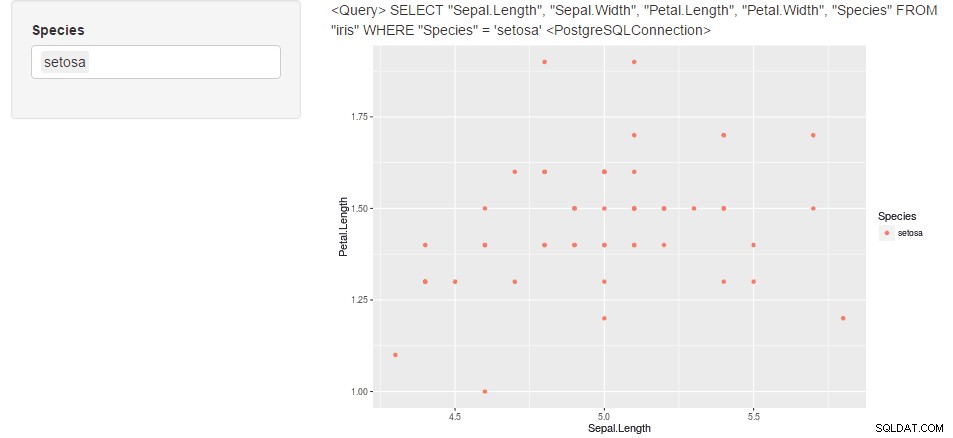Het probleem is de manier waarop de query wordt opgebouwd wanneer u slechts één . selecteert element en gebruik de IN exploitant. De dplyr vertaling naar SQL voegt niet het juiste haakje toe en faalt dus. Dit probleem is hier
uitvoerig besproken .
Een manier om dit te omzeilen is door een andere instructie door te geven aan filter() wanneer length van invoer is gelijk aan 1 (zie voorbeeld hieronder).
Dit is wat er gebeurt:
tbl(mydb, "iris") %>%
filter(Species %in% c("setosa", "versicolor")) %>%
.$query
Geeft de juiste SQL zoeksyntaxis:
<Query> SELECT "Sepal.Length", "Sepal.Width", "Petal.Length", "Petal.Width", "Species"
FROM "iris"
WHERE "Species" IN ('setosa', 'versicolor')
<PostgreSQLConnection>
En, indien uitgevoerd, geeft het het verwachte:
#Source: postgres 9.3.13 [[email protected]:5432/csvdump]
#From: iris [100 x 5]
#Filter: Species %in% c("setosa", "versicolor")
#
# Sepal.Length Sepal.Width Petal.Length Petal.Width Species
# (dbl) (dbl) (dbl) (dbl) (chr)
#1 5.1 3.5 1.4 0.2 setosa
#2 4.9 3.0 1.4 0.2 setosa
#3 4.7 3.2 1.3 0.2 setosa
#4 4.6 3.1 1.5 0.2 setosa
#5 5.0 3.6 1.4 0.2 setosa
#6 5.4 3.9 1.7 0.4 setosa
#7 4.6 3.4 1.4 0.3 setosa
#8 5.0 3.4 1.5 0.2 setosa
#9 4.4 2.9 1.4 0.2 setosa
#10 4.9 3.1 1.5 0.1 setosa
#.. ... ... ... ... ...
Eens kijken wat er gebeurt als je een enkel element probeert door te geven:
tbl(mydb, "iris") %>%
filter(Species %in% "setosa") %>%
.$query
De vraag zal zijn:
<Query> SELECT "Sepal.Length", "Sepal.Width", "Petal.Length", "Petal.Width", "Species"
FROM "iris"
WHERE "Species" IN 'setosa'
<PostgreSQLConnection>
Wat, indien uitgevoerd, resulteert in de volgende fout:
Dat komt omdat voor een enkel element de dplyr vertaling naar SQL query voegt niet het juiste haakje toe. Let op hoe het is 'setosa' in plaats van ('setosa') .
Om dat te omzeilen, kunnen we het volgende doen:
if(length(input$Species) == 1) {
tbl(mydb, "iris") %>%
filter(Species == input$Species) %>%
}
Die een syntactisch geldige SQL . zal bouwen vraag:
<Query> SELECT "Sepal.Length", "Sepal.Width", "Petal.Length", "Petal.Width", "Species"
FROM "iris"
WHERE "Species" = 'setosa'
<PostgreSQLConnection>
In het volgende voorbeeld wordt dit probleem omzeild. Hier geef ik de app de opdracht om filter(Species == ...) . door te geven if input$Species is van length 1 en filter(Species %in% ...) anders.
ShinyApp
server <- function(input, output) {
selectedQuery <- reactive({
if(length(input$Species) == 1) {
tbl(mydb, "iris") %>%
filter(Species == input$Species) %>%
.$query
}
else(
tbl(mydb, "iris") %>%
filter(Species %in% input$Species) %>%
.$query
)
})
selectedData <- reactive({
if(length(input$Species) == 1) {
tbl(mydb, "iris") %>%
filter(Species == input$Species) %>%
data.frame
}
else(
tbl(mydb, "iris") %>%
filter(Species %in% input$Species) %>%
data.frame
)
})
output$plot <- renderPlot({
ggplot2::qplot(Sepal.Length, Petal.Length, data = selectedData(), color = Species)
})
output$query <- renderPrint({
selectedQuery()
})
}
ui <- fluidPage(
sidebarLayout(
sidebarPanel(
selectInput("Species", "Species",
tbl(mydb, "iris") %>%
data.frame %>%
.$Species %>%
unique,
selected = "setosa", multiple = TRUE)
),
mainPanel(
textOutput("query"),
plotOutput("plot")
)
)
)
shinyApp(ui = ui, server = server)

